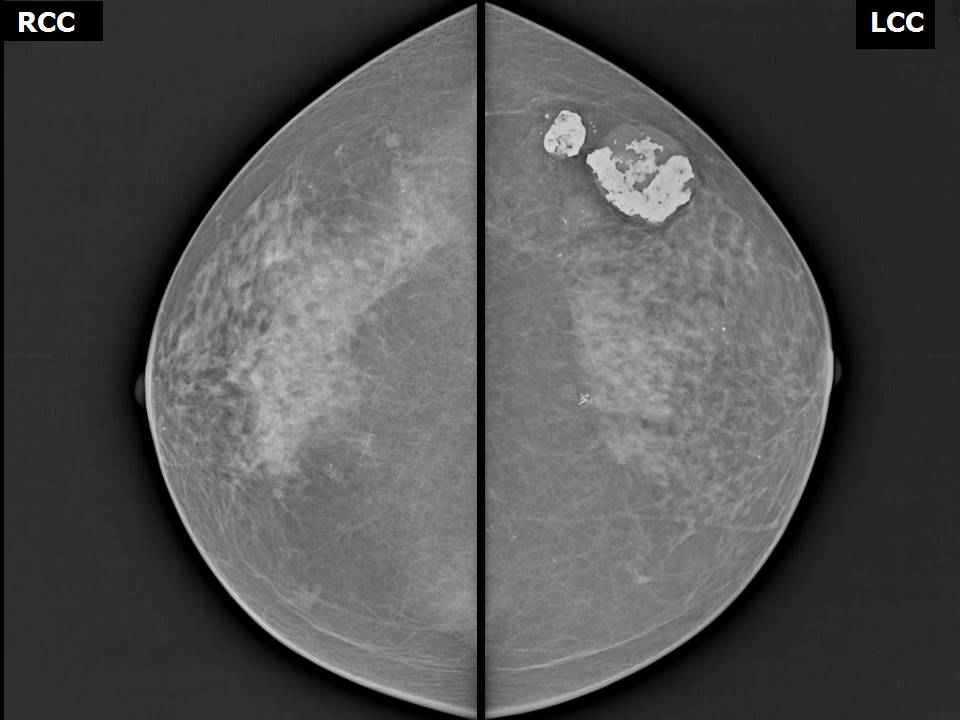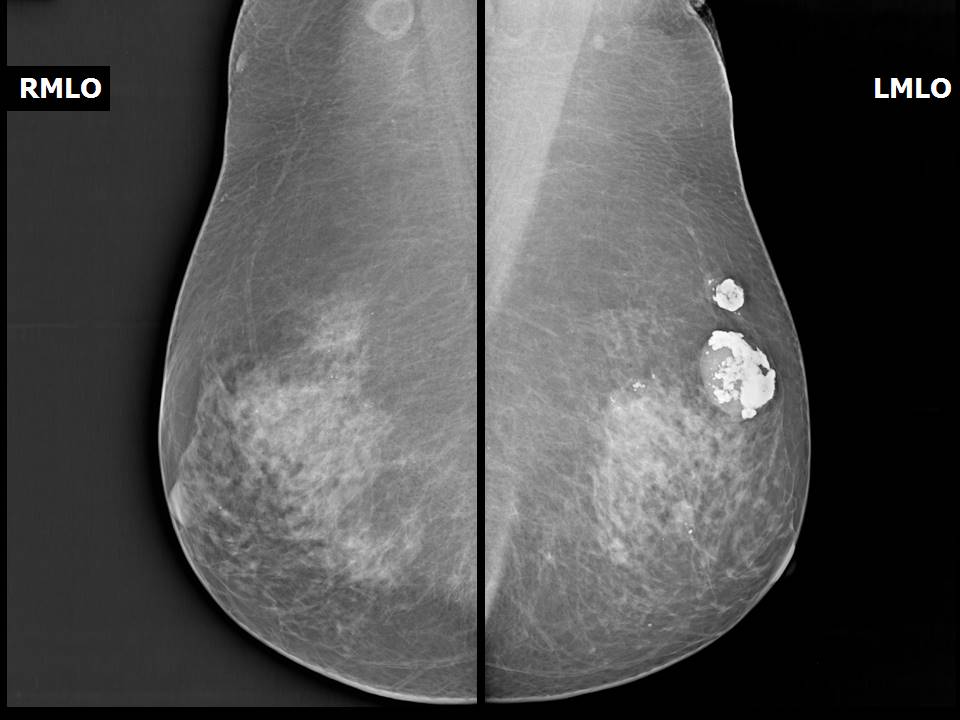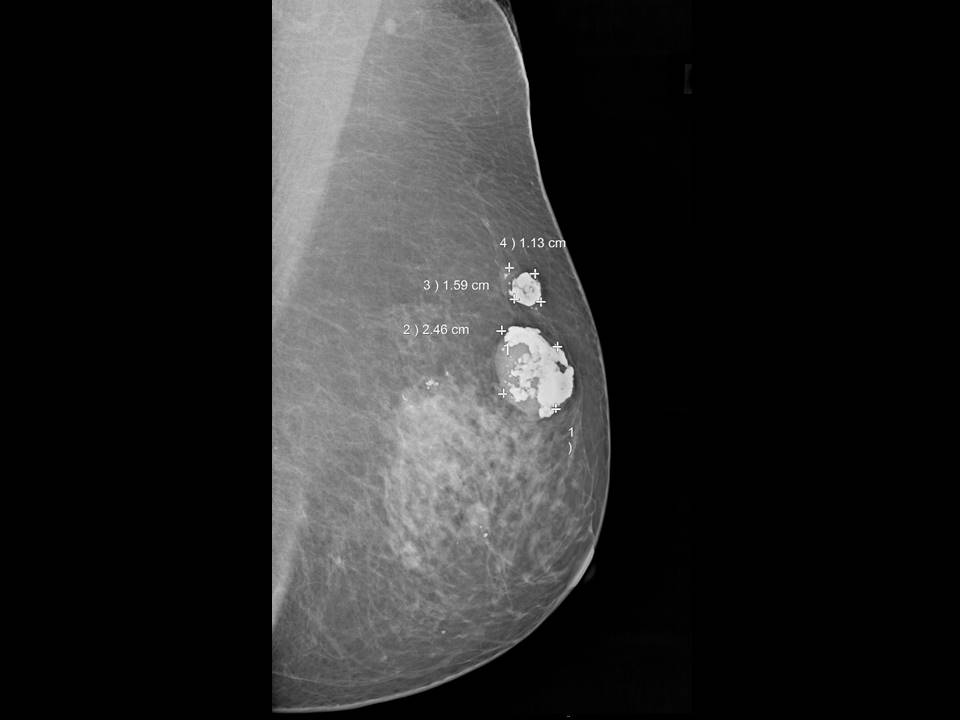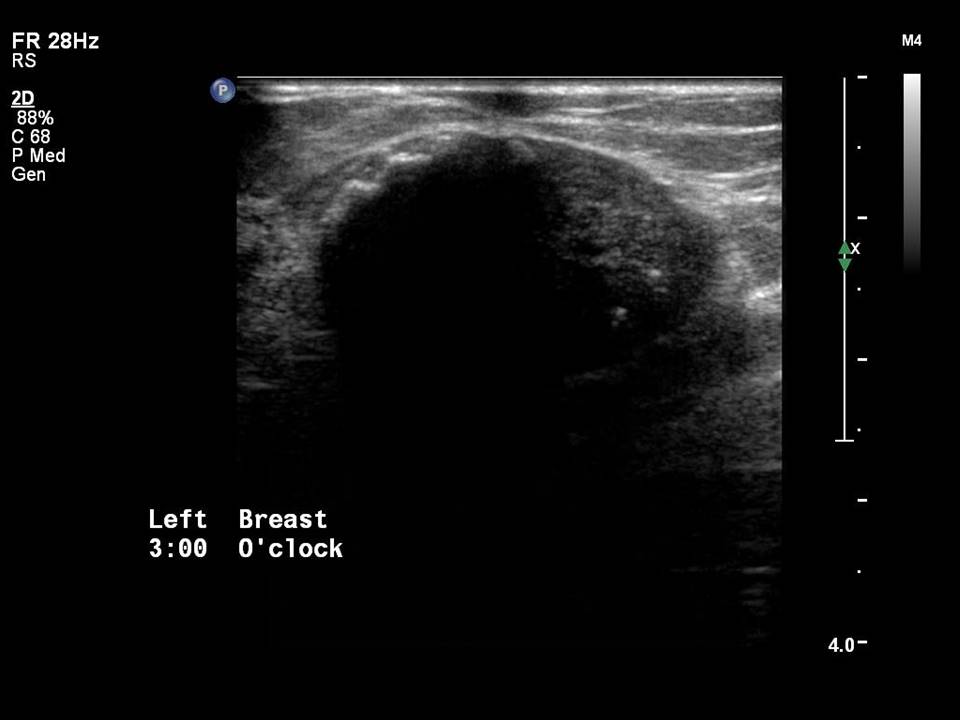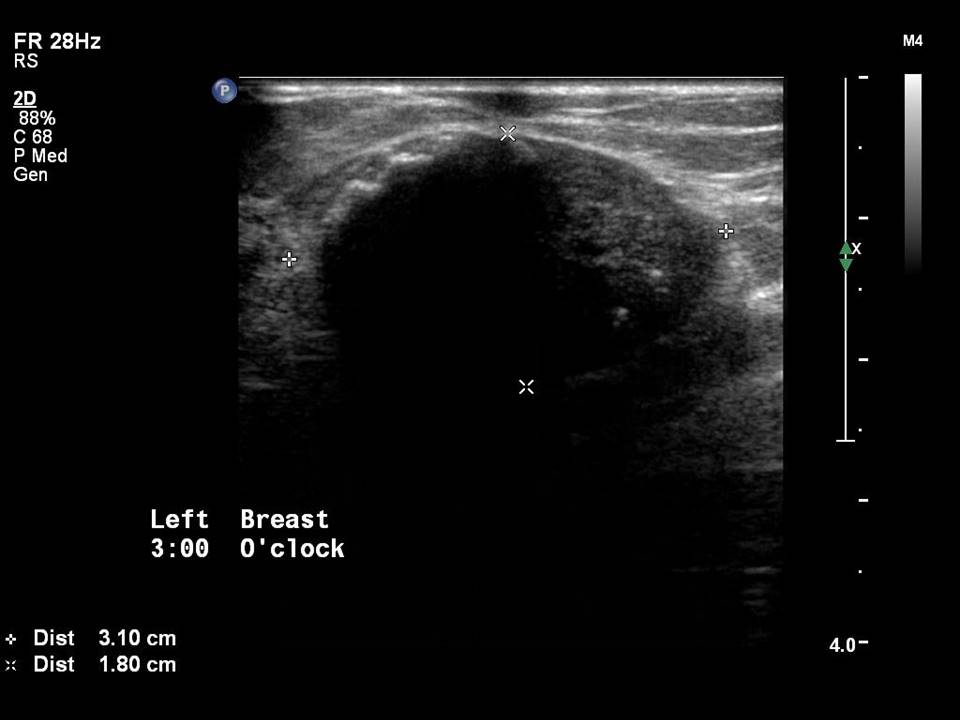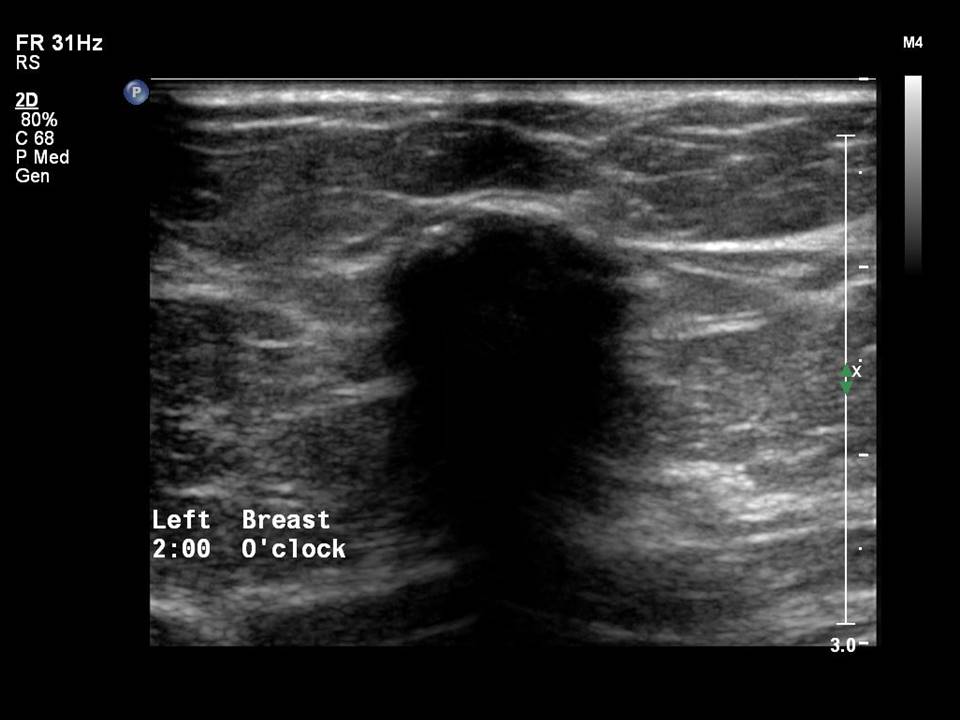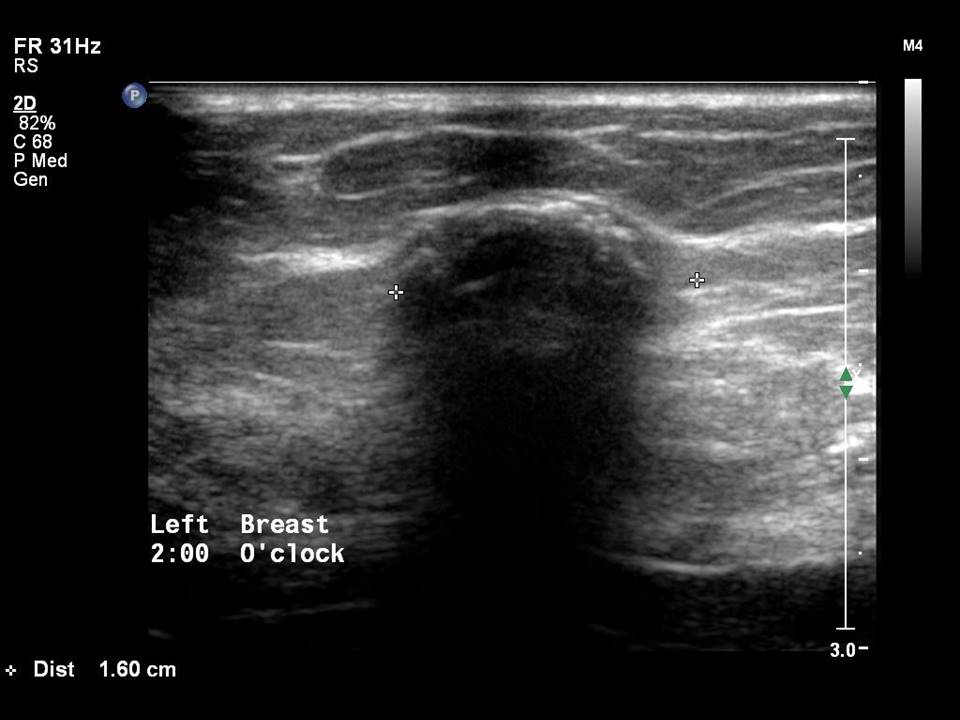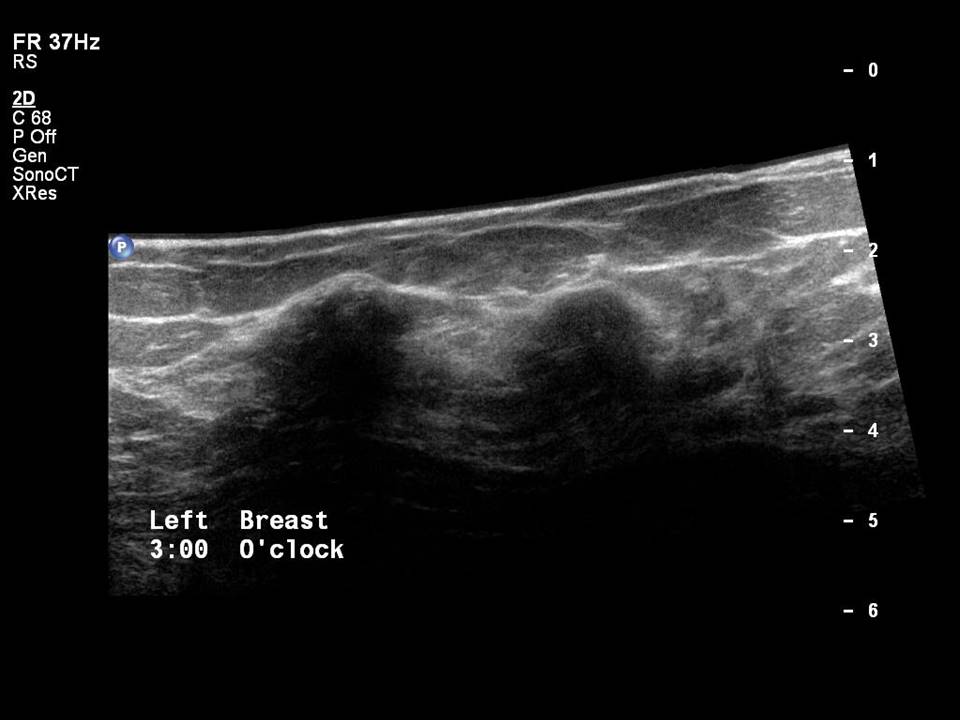Home / Training / Manuals / Atlas of breast cancer early detection / Cases
Atlas of breast cancer early detection
Filter by language: English / Русский
Go back to the list of case studies
.png) Click on the pictures to magnify and display the legends
Click on the pictures to magnify and display the legends
| Case number: | 158 |
| Age: | 74 |
| Clinical presentation: | Postmenopausal woman with average risk of developing breast cancer presented with a hard palpable lump in the outer quadrant of the left breast. The lump had been present for 15 years but recently it had developed a hard stony texture. |
Mammography:
| Breast composition: | ACR category c (the breasts are heterogeneously dense, which may obscure small masses) | Mammography features: |
| ‣ Location of the lesion: | Left breast, upper outer quadrant at 3 o’clock, 4.0 cm from the nipple, anterior and middle thirds |
| ‣ Mass: | |
| • Number: | 1 |
| • Size: | 2.5 × 1.8 cm |
| • Shape: | Oval |
| • Margins: | Circumscribed |
| • Density: | Equal with dense calcifications |
| ‣ Calcifications: | |
| • Typically benign: | Popcorn-like |
| • Suspicious: | None |
| • Distribution: | Within mass |
| ‣ Architectural distortion: | None |
| ‣ Asymmetry: | None |
| ‣ Intramammary node: | None |
| ‣ Skin lesion: | None |
| ‣ Solitary dilated duct: | None |
| ‣ Associated features: | Calcifications |
| Breast composition: | ACR category c (the breasts are heterogeneously dense, which may obscure small masses) | Mammography features: |
| ‣ Location of the lesion: | Left breast, upper outer quadrant at 2 o’clock, 6.0 cm from the nipple, anterior and middle thirds |
| ‣ Mass: | |
| • Number: | 1 |
| • Size: | 1.6 × 1.0 cm |
| • Shape: | Oval |
| • Margins: | Circumscribed |
| • Density: | Equal with dense macrocalcification |
| ‣ Calcifications: | |
| • Typically benign: | Macrocalcifications |
| • Suspicious: | None |
| • Distribution: | Within mass |
| ‣ Architectural distortion: | None |
| ‣ Asymmetry: | None |
| ‣ Intramammary node: | None |
| ‣ Skin lesion: | None |
| ‣ Solitary dilated duct: | None |
| ‣ Associated features: | Calcifications |
| Breast composition: | ACR category c (the breasts are heterogeneously dense, which may obscure small masses) | Mammography features: |
| ‣ Location of the lesion: | Left breast, inner quadrant, anterior and middle thirds |
| ‣ Mass: | |
| • Number: | 1 |
| • Size: | None |
| • Shape: | None |
| • Margins: | None |
| • Density: | None |
| ‣ Calcifications: | |
| • Typically benign: | Round |
| • Suspicious: | None |
| • Distribution: | Diffuse |
| ‣ Architectural distortion: | None |
| ‣ Asymmetry: | None |
| ‣ Intramammary node: | None |
| ‣ Skin lesion: | None |
| ‣ Solitary dilated duct: | None |
| ‣ Associated features: | None |
| Breast composition: | ACR category c (the breasts are heterogeneously dense, which may obscure small masses) | Mammography features: |
| ‣ Location of the lesion: | Right breast, inner and outer quadrants |
| ‣ Mass: | |
| • Number: | 0 |
| • Size: | None |
| • Shape: | None |
| • Margins: | None |
| • Density: | None |
| ‣ Calcifications: | |
| • Typically benign: | Coarse, round, and vessel calcification |
| • Suspicious: | None |
| • Distribution: | None |
| ‣ Architectural distortion: | None |
| ‣ Asymmetry: | None |
| ‣ Intramammary node: | None |
| ‣ Skin lesion: | None |
| ‣ Solitary dilated duct: | None |
| ‣ Associated features: | Calcifications |
Ultrasound:
| Ultrasound features: Left breast, outer quadrants at 3 o’clock | |
| ‣ Mass | |
| • Location: | Left breast, outer quadrants at 3 o’clock |
| • Number: | 1 |
| • Size: | 3.1 × 1.8 cm |
| • Shape: | Oval |
| • Orientation: | Parallel |
| • Margins: | Circumscribed |
| • Echo pattern: | Hypoechoic with dense macrocalcification |
| • Posterior features: | Strong posterior shadowing |
| ‣ Calcifications: | Present in mass |
| ‣ Associated features: | None |
| ‣ Special cases: | None |
| Ultrasound features: Left breast, outer quadrants at 2 o'clock | |
| ‣ Mass | |
| • Location: | Left breast, outer quadrants at 2 o'clock |
| • Number: | 1 |
| • Size: | 1.6 × 1.0 cm |
| • Shape: | Oval |
| • Orientation: | Parallel |
| • Margins: | Circumscribed |
| • Echo pattern: | Hypoechoic with dense macrocalcification |
| • Posterior features: | Posterior shadowing |
| ‣ Calcifications: | Present in mass |
| ‣ Associated features: | None |
| ‣ Special cases: | None |
BI-RADS:
BI-RADS Category: 2 (benign)Case summary:
| Postmenopausal woman presented with a stony hard lump in the left breast. Diagnosed as involuting (partially calcified) fibroadenomas, BI-RADS 2 on imaging. |
Learning points:
|




